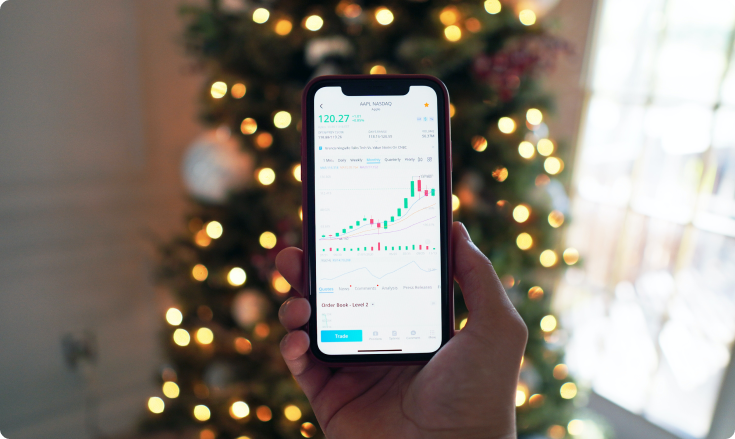How To Get Started With Stock Trading?

When you’re just starting with trading, it can be difficult to decide which instrument you’re going to trade with. Should you go for gold or maybe oil? Currency pairs maybe?
While those are all great instruments to trade with, still the first trading association for a newbie is usually stock trading. Stocks allow you to potentially make a profit by predicting whether a company (Apple for example) will have good business results or not. This makes stocks an ideal instrument for beginners because they can learn how trading works and at the same time trade on an instrument that is easier to understand concept-wise. Stocks are instruments of the financial market that are an excellent way to build investment portfolios and have an additional source of income with a minimum time and effort.
Just like many other skills, stocks trading can be easy to start with but takes a while to master. But let’s start at the beginning.
What is stock trading?
Stock trading is buying and selling shares of publicly traded companies. Some of the popular stocks you might’ve heard of are Tesla (TSLA), Apple (AAPL), Alibaba (BABA), Amazon (AMZN), Microsoft (MSFT), etc. Those are just some of the most popular companies that are publicly traded, but you can find many more that you could trade with and potentially profit from the price movements of their stocks.
Whenever you buy a stock, someone is selling that stock to you. Likewise, when you’re looking to sell your stock, someone else will be buying it from you. The market is huge and many people are interested in buying or selling any given stock at any time.
Price of the stock depends on many factors and one of the most important ones is the number of buyers and sellers in the market. If more people are interested in buying the stock compared to the number of people wanting to sell it, the stock price will go up as the demand is higher. If people are more interested in selling the stock that will push the price downwards.
How to learn about stock trading?
Learn to read and analyze
There is no shortage of trading materials out there and many of them discuss the stock market in depth. Many of those materials are free so there’s no need to pay a lot of money in order to get started.
It’s important not to focus too much on one aspect of trading. No matter which financial instrument you’re trading with, you need to know about the market in general since many factors always come into play. Even if something doesn’t feel relevant for your particular situation, it can turn out to be very useful in the future. Trading launches a journey that often ends up at a destination not anticipated at the starting line. Your broad and detailed market background will come in handy over and over again, even if you think you know exactly where you’re going right now, or what your next step will be.
Follow the market news and charts and trade daily and you’ll become a stocks trading pro. News sites such as Yahoo Finance, Google Finance, and CBS MoneyWatch serve as great resources for new investors. For more sophisticated coverage, you need to look no further than The Wall Street Journal and Bloomberg.
As for the analysis, you should study the basics of technical analysis and look at price charts—lots of them—in all time frames. Read and analyze company spreadsheets, because they offer a trading edge over those who ignore them.
Practice trading via demo account
A trading demo account, or demonstration account, is a type of account offered by tradingplatforms and enables a prospective customer to experiment with the trading platform and its various features before deciding to activate a live account. A demo account allows users to buy and sell stocks using paper trading, but test those trades under real, live market situations.
Paper trading, or so called virtual trading offers a perfect solution for the beginners, allowing the user to follow real-time market actions, making buying and selling decisions that form the outline of a theoretical performance record. It usually involves the use of a stock market simulator, that has the look and feel of an actual stock exchange's performance. Make lots of trades, using different holding periods and strategies, and then analyze the results for obvious flaws.
Additional expertise
Though experience is a fine teacher, don't forget about additional education as you proceed on your trading career. Whether online or in-person, classes can be beneficial, and you can find them at levels ranging from novice (with advice on how to analyze the aforementioned analytic charts, for example) to pro. More specialized webinars and seminars—often conducted by a professional trader—can provide valuable insight into the overall market and specific investment strategies. Most focus on a specific type of asset, a particular aspect of the market, or a trading technique. Some may be academic, while others are more like workshops in which you actively take positions, test out entry and exit strategies, and engage in other exercises (often with a simulator).
Paying for research and analysis can be both educational and useful. Some investors may find watching or observing market professionals to be more beneficial than trying to apply newly learned lessons themselves.
It's also useful to get yourself a mentor—a hands-on coach to guide you, critique your technique, and offer advice. If you don't know one, you can buy one. Many online trading schools offer mentoring as part of their continuing educational programs.
How can you get started with stock trading in 3 simple steps?

1. Open a trading account
When you open a trading account, it’s necessary to do it with a regulated and trusted online broker which offers you a variety of stocks to invest in. If you’re just starting out with trading stocks, you should first open a demo account and trade for a while there until you’re comfortable to switch to a real trading account.
2. Manage your risk
Once you start trading with real money, you have to develop a risk management strategy. Every position you open can and should be secured with market limit orders such as stop loss and take profit orders, in order to maximize your profits and reduce potential losses.
A stop-loss point is the price at which a trader will sell a stock and take a loss on the trade. This often happens when a trade does not go the way a trader hoped. Stop loss points are designed to prevent the "it will come back" mentality and limit losses before they escalate.
On the other hand, a take-profit point is the price at which a trader will sell a stock and take a profit on the trade. This is when the additional upside is limited given the risks. For example, if a stock is approaching a key resistance level after a large move upward, traders may want to sell before a period of consolidation takes place.
Another important aspect of risk management is diversification. Making sure you make the most of your trading means never putting your eggs in one basket. If you put all your money in one stock or one instrument, you're setting yourself up for a big risk. So, remember to diversify your investments—across both industry sectors as well as market capitalization and geographic region. Not only does this help you manage your risk, but it also opens you up to more opportunities.
3. Keep a trading journal
Almost all successful traders have a trading journal and make regular retrospectives of their journal entries to spot and eliminate any recurring patterns that lead to losing trades. This is a simple, yet very effective method that can help you improve your trading performance. By keeping a trading journal that would document all your trades and their results, can give you some important long term insights and set the foundation of your path to expert trader status. It also allows identifying reasons why certain trades worked well, while others didn’t.
Trading journals should include all necessary elements that describe a trade, such as the date and time of the trade, the traded instrument, the direction of the trade, entry and exit prices, position sizes and the result of the trade once it’s closed.
Conclusion
If you’ve been following a company (or a couple of them) and you’re familiar with their products and services, you can often deduce whether the value of their stock will go up or down. Stocks trading allows you to profit from those insights and that’s why stocks are among the most popular trading instruments.
Pick a good online broker which has the stocks that you want to trade with and open an account with them.
Don’t forget to manage your risk. Regardless of the stock you’re trading with, the price can always go in an unpredictable direction and you need to ensure that any potential losses are minimal.
Sources Consulted:
1. Kennon, J. Learn how to trade stocks online with this simple guide. https://www.thebalance.com/stock-trading-101-358115
2. Farley, A. Learn how to trade the market in 5 steps. https://www.investopedia.com/learn-how-to-trade-the-market-in-5-steps-4692230 (2021)
3. Reinkensmeyer, B. 10 great ways to learn stock trading in 2021. https://www.stocktrader.com/learn-stock-trading/ (2017)
4. Kenton, W. Trading demo account. https://www.investopedia.com/terms/d/demo-account.asp
5. Konchar, P. https://mytradingskills.com/trading-journal-guide
6. Farley, A. https://www.investopedia.com/learn-how-to-trade-the-market-in-5-steps-4692230
LimitPrime © 2026
Begin to invest and
start earning today!
Categories
Do you need personalized assistance?
READ MORE INTERESTING ARTICLES

Diversificationnoun the action of diversifying something or the fact of becoming more diverse. a trading strategy that reduces risk. D...
Read More
As any risk disclosure will tell you, trading financial instruments put the trader at risk of losing some or all of their allocated cap...
Read More
What are indices?Indices measure the performance of a group of stocks, bonds or other investments. These investments are often grouped...
Read More